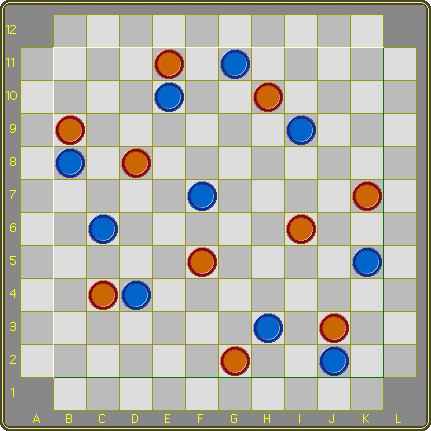Play Pylyx interactively
Rules
There are two players, Black and White. The board is 12x12 of which the corners are omitted. There are 10 white and 10 black checkers.
The placement phase
Starting with White, players alternately place one man on a square of the central 10x10 area. The general restriction is that a checker may not be placed on a cell of which the corresponding row or column already holds a like colored checker. It is possible that a player cannot legally enter because the only available cells have been occupied by the opponent. He then must make a move according to the conditions mentioned in the movement phase, to vacate a cell for entering. If a player can legally enter a piece he must do so.
Once the placement phase has been completed, the movement phase begins.
 | The movement phase The diagram shows a possible position at the end of the placement phase. Players now in turn must move one piece. Moving is compulsory. In the game black stacks and white stacks arise, but no mixed stacks. Men and stacks are called 'pieces'. Pieces may never move over other pieces, regardless of color. Pieces may not land on opposing pieces. Pieces may land on pieces of like color, forming stacks. Stacks may move as a whole or as any top part, leaving the bottom part behind.
Object The goal is to make a stack of 10. If neither player can succeed, the game is a draw. |
Strategy
Because stacks may split, an immobile stack will always have mobile top parts. If a player creates a stack of four or more though, that's likely the intended square to build his stack of ten on. Having to break it down by moving a top part is not the most efficient way to do it.
For maximum flexibility, 3-3-2-2 or 3-3-3-1 appear to be the best sets to fix a square and stack as final destination. Of course one should not end with a single on the wrong diagonal subgrid.
A single on the edge can be easily blocked, so don't put one there lightly. If it occurs, the way to liberate it is to move a double onto it and leave with a triple. A double blocked on the side can also leave diagonally in two steps as two singles. There are several liberation tactics, but they are time consuming. Better avoid singles on the edges whenever possible.
Here's an example game:
| no Sound | ||||
|
to move
in hand
|
|
|||
|
Christian Freeling - Ed van Zon (0-1)
|
||||
How I invented ... Pylyx
Pylyx © MindSports






















